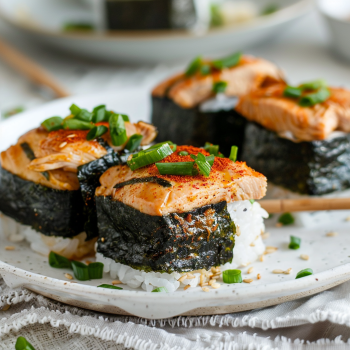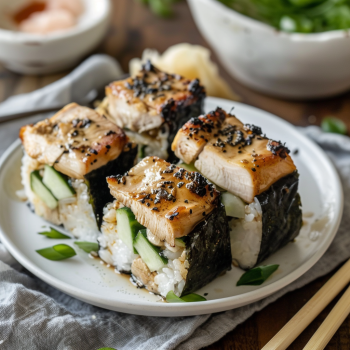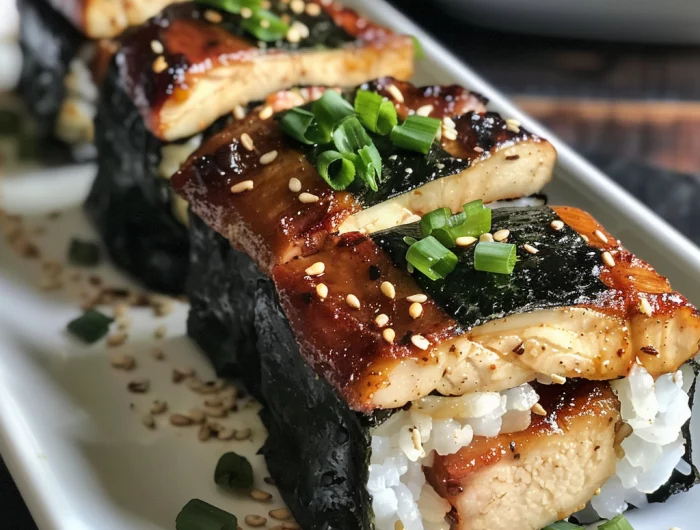All Question You Need
Homemade Chicken Musubi recipe! This delightful twist on the classic Hawaiian snack features tender, marinated chicken thighs layered with sushi rice and wrapped in a sheet of nori. Perfect for a quick snack, lunchbox treat, or party appetizer, these savory musubi are sure to transport your taste buds to paradise with every bite.
Why You’ll Love It:
- Tender, juicy chicken thighs marinated in a flavorful sauce.
- Sushi rice seasoned with a hint of sweetness and tanginess.
- Crispy nori seaweed wrapper that adds a delicious umami flavor.
- Portable and convenient snack that’s perfect for on-the-go enjoyment.
Personal Story: My love for Chicken Musubi Recipe began during a trip to Hawaii, where I had my first taste of this beloved island snack. I was immediately hooked by the combination of tender chicken, sticky rice, and savory nori. Determined to recreate the flavors at home, I set out to develop the perfect Chicken Musubi recipe. After much experimentation, I perfected the marinade, rice seasoning, and assembly technique to create musubi that rival those found in Hawaii. Now, whenever I make Chicken Musubi, I’m reminded of the warm Hawaiian sun, gentle ocean breeze, and the joy of discovering new culinary delights.
Key Features:
- Customizable marinade that allows you to adjust the flavor to your preference.
- Simple ingredients that can be easily found at most grocery stores.
- Versatile snack that can be enjoyed as a light meal or appetizer.
- Fun and interactive to make, perfect for involving family and friends in the kitchen.

What Is Musubi?
Musubi is a popular snack or light meal in Hawaiian cuisine, consisting of a block of cooked rice often topped with a slice of grilled Spam, wrapped in a strip of nori (seaweed). It’s essentially a portable and convenient way to enjoy rice and protein together, typically eaten with your hands.
Originally inspired by Japanese onigiri (rice balls), musubi became a staple in Hawaii due to its convenience and versatility. While Spam musubi is the most common variation, featuring Spam as the protein, there are many other variations, including chicken, pork, shrimp, or even vegetarian options.
Musubi is often seasoned with ingredients like soy sauce, sugar, and sometimes furikake (a Japanese seasoning blend) for added flavor. It’s enjoyed as a quick snack, picnic food, or even as part of a meal, and it’s widely available in convenience stores, markets, and roadside stands throughout Hawaii.
Health Benefits Of Chicken Musubi Recipe
Chicken musubi can offer several health benefits, especially when prepared with wholesome ingredients and served in moderation. Here are some potential health benefits of chicken musubi:
- Protein: Chicken is a good source of lean protein, which is essential for building and repairing tissues in the body. Including protein-rich foods like chicken in your diet can help support muscle health and keep you feeling full and satisfied.
- Whole Grains: When made with brown or whole grain rice, chicken musubi provides complex carbohydrates, which are an important source of energy for the body. Whole grains also offer fiber, vitamins, and minerals that are beneficial for digestive health and overall well-being.
- Essential Nutrients: Chicken is rich in essential nutrients such as vitamin B12, which is important for nerve function and energy metabolism, as well as phosphorus, which supports bone health. Additionally, rice provides important nutrients like manganese, selenium, and magnesium.
- Portion Control: Chicken musubi is typically served in individual portions, making it easy to control portion sizes and avoid overeating. Enjoying chicken musubi as part of a balanced meal can help promote portion control and prevent excessive calorie intake.
- Customization: Chicken musubi can be customized with additional ingredients such as vegetables or fruits, offering an opportunity to increase the nutritional content of the dish. Adding vegetables like lettuce, cucumber, or avocado can provide vitamins, minerals, and antioxidants.
- Low in Saturated Fat: Grilled chicken is lower in saturated fat compared to processed meats like Spam, which is commonly used in traditional musubi recipes. Choosing grilled chicken as the protein option can help reduce saturated fat intake and promote heart health.
While chicken musubi can be a tasty and satisfying dish, it’s important to enjoy it as part of a balanced diet that includes a variety of nutrient-rich foods. Additionally, be mindful of portion sizes and cooking methods to maximize the health benefits of this delicious Hawaiian-inspired dish.
What is Musubi Sauce Made Of?
Musubi sauce, also known as teriyaki glaze, is typically made from a combination of soy sauce, sugar, rice vinegar, and sometimes additional ingredients for flavor, such as garlic, ginger, or sesame oil. It’s a savory-sweet sauce that adds delicious flavor to musubi and other dishes.
Here’s a simplified version of musubi sauce without listing specific ingredients and instructions:
- Musubi sauce is typically made from a combination of soy sauce, sugar, rice vinegar, and sometimes other ingredients like garlic, ginger, or sesame oil.
- The soy sauce provides a salty base, while the sugar adds sweetness and caramelization when cooked.
- Rice vinegar adds acidity and tanginess to balance the flavors of the sauce.
- Additional ingredients like minced garlic and grated ginger can enhance the flavor profile of the sauce, adding depth and complexity.
- Some recipes may also include sesame oil for nuttiness and richness.
Feel free to adjust the ingredients and quantities according to your taste preferences. Experiment with different variations to create a musubi sauce that suits your palate and complements your favorite musubi recipe.
How To Serve Chicken Musubi?
Chicken musubi is typically served as a snack or light meal, either on its own or as part of a larger spread. Here are a few ways to serve chicken musubi:
- On its Own: Enjoy chicken musubi as a satisfying snack or light meal on its own. It’s perfect for a quick bite when you’re on the go or as a simple lunch option.
- With Side Dishes: Serve chicken musubi alongside other side dishes to create a complete meal. Some traditional Hawaiian sides that pair well with musubi include macaroni salad, pineapple slices, or fresh fruit.
- In a Bento Box: Pack chicken musubi in a bento box along with other goodies like vegetable sticks, edamame, and sliced fruit for a fun and portable lunch option.
- At a Potluck or Party: Bring chicken musubi to a potluck or party as a crowd-pleasing appetizer. Arrange them on a platter with toothpicks for easy serving.
- With Dipping Sauce: Serve chicken musubi with a side of musubi sauce or your favorite dipping sauce for extra flavor. Soy sauce, teriyaki sauce, or sweet chili sauce are all great options.
However you choose to serve it, chicken musubi is sure to be a hit with its delicious combination of seasoned rice, grilled chicken, and crispy nori.
Cooking Tips:
- If you don’t have a rice cooker, you can cook the sushi rice on the stovetop. Simply combine the rinsed rice and water in a pot, bring to a boil, then reduce heat to low, cover, and simmer for 18-20 minutes, or until the water is absorbed and the rice is tender.
- Make sure to let the rice cool slightly before using it to assemble the musubi to prevent it from becoming too sticky and difficult to work with.
- You can adjust the seasoning of the sushi rice to suit your taste by adding more or less rice vinegar, sugar, and salt.
- Feel free to customize the marinade for the chicken by adding your favorite herbs, spices, or additional ingredients like chili flakes or lime juice.
- Musubi can be enjoyed warm or at room temperature. Store any leftovers in an airtight container in the refrigerator for up to 2-3 days.
Variations:
- Teriyaki Chicken Musubi: Use your favorite teriyaki sauce in place of the soy sauce-based marinade for a sweeter, stickier glaze on the chicken.
- Spicy Chicken Musubi: Add a few dashes of hot sauce or chili flakes to the marinade for a spicy kick.
- Vegetarian Musubi: Replace the chicken with grilled or sautéed tofu slices for a meat-free alternative.
- Spam Musubi: Substitute cooked slices of spam for the chicken for a classic Hawaiian twist on the musubi.
Make It Healthier:
- Use lean chicken breast instead of chicken thighs to reduce the fat content of the musubi.
- Opt for brown rice or quinoa instead of sushi rice for a higher-fiber, lower-carb option.
- Load up the musubi with extra vegetables, such as sliced avocado, cucumber, or lettuce, for added nutrition and freshness.
- Grill the chicken instead of pan-frying it to reduce the amount of oil used in cooking.
Closing: Transport your taste buds to the tropical shores of Hawaii with our Homemade Chicken Musubi—a flavorful twist on a beloved island snack! With its tender marinated chicken, seasoned sushi rice, and crispy nori seaweed wrapper, this musubi recipe captures the essence of Hawaiian cuisine in every bite. Whether enjoyed as a quick snack, lunchbox treat, or party appetizer, these savory musubi are sure to delight with their irresistible flavor and homemade charm. So grab your ingredients, fire up the grill, and get ready to savor a taste of paradise with our Homemade Chicken Musubi recipe!

Frequently Asked Questions:
Can I use chicken breast instead of chicken thighs for this recipe?
Yes, you can use chicken breast if you prefer. Keep in mind that chicken breast tends to be leaner and may dry out more easily, so be careful not to overcook it. You can also pound the chicken breast to an even thickness before marinating and cooking to ensure even cooking.
Can I make musubi without a musubi mold?
While a musubi mold makes it easier to assemble perfectly shaped musubi, you can still make musubi without one. Simply use your hands to shape the rice and chicken into rectangular blocks, then wrap them in the nori seaweed strips. Press firmly to seal the nori around the rice and chicken, and you’re good to go!
Can I use store-bought teriyaki sauce instead of making my own marinade?
Yes, you can use store-bought teriyaki sauce if you prefer. Simply marinate the chicken thighs in the teriyaki sauce for at least 30 minutes before cooking. Keep in mind that store-bought sauces may vary in flavor and consistency, so adjust the seasoning and thickness as needed.
Can I freeze musubi?
Musubi can be frozen for longer storage. Wrap each musubi individually in plastic wrap or aluminum foil, then place them in a resealable freezer bag or container. They can be frozen for up to 1-2 months. To reheat, thaw the musubi in the refrigerator overnight, then microwave or reheat in the oven until warmed through.
Can I use a different type of rice for musubi?
While sushi rice is traditional for musubi, you can use other types of rice if desired. Short-grain rice or jasmine rice would work well as alternatives. Just keep in mind that the texture and stickiness may vary depending on the type of rice used. Adjust the seasoning and cooking method accordingly to achieve the desired results.
You Might Be Interested In
- Easy Vanilla Milkshakes Recipe
- Buttered Potatoes with Garlic and Parsley
- Spinach and Feta Cheese Baked Frittata Recipe


